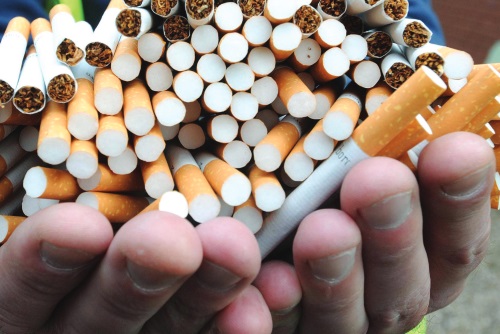
Counterfeit and contraband cigarettes account for more than 9 per cent of cigarette consumption in Europe, a new report reveals.
Although some 48.3 billion fake fags were smoked in 2016, this figure is down by 8.8 per cent on 2015's findings when 53 billion counterfeit and contraband (C&C) cigarettes were puffed.
The 2016 results represent a tax loss to the region of €10.2bn, making the illicit trade one of the largest major competitors within the cigarette market and a substantial source of income for organised crime groups (OCGs).
Illicit cigarettes from outside the EU accounted for 86 per cent of the C&C identified in the study. Ukrainian-labelled product was the largest single source, representing 12 per cent of total C&C flows. Belarus and Algeria accounted for 10 per cent and 7 per cent of C&C respectively. Poland was the largest source of C&C within the EU.
Compiled by consultancy firm KPMG for the Royal United Services Institute for Defence and Security Studies (RUSI), the 2016 Project Sun report is the annual study on the scale and development of the illicit cigarette market in the EU, Norway and Switzerland.
"Fundamentally, the rewards for engagement in the illicit cigarette trade remain too high and the risks too low. Until this balance is altered, the trade will remain a key focus of organised crime activity across Europe," the report said. "The aim must be to create a more hostile environment for OCGs exploiting a trade that remains, to many citizens, invisible, accessible and, most damagingly of all, broadly acceptable."
C&C consumption by volume remained highest in France at 8.96 billion cigarettes, followed by Poland and the UK at 6.16 billion and 5.55 billion respectively, while C&C as a percentage of consumption remained above 10 per cent for 12 of the 30 countries in the study.
The findings reveal that C&C continued to decline at a greater rate than legal domestic consumption, reversing the trend witnessed from 2012 to 2014.
This can be attributed to macroeconomic factors, including economic growth, reduced unemployment and an increase in personal disposable income, all of which have reduced demand for fake fags, the report notes. However, the illicit cigarette trade is still seen as socially acceptable by many consumers who view it as a 'victimless' crime, it adds.
Meanwhile, the report claims that ongoing law enforcement and border controls also contributed to reducing the supply of C&C products into the EU.
For instance, intensified activities on the Eastern EU border clamped down on the trade while 55 illegal factories in the EU were shut down and 3.8 billion cigarettes seized, the vast majority of which were illicit whites. This activity is significant given that the illicit cigarette trade has traditionally not received the same level of attention or strict penalties as other forms of crime, the report says.
According to the RUSI analysis as part of the report, the organised crime groups (OCGs) engaged in the illicit cigarette trade are becoming increasingly diverse in the routes and methods they employ and in the products they manufacture and sell. For instance, they operate increasingly as flexible networks, cooperating on an ad hoc basis for mutual benefit, and they exploit free trade zones, online marketplaces and postal and courier services to distribute the fake products, as well as quickly identifying emerging business opportunities.
"Adopting a 'little and often' approach to smuggling, the OCGs involved are able to slip under authorities' thresholds for investigation and to adapt routes in response to law-enforcement action," the report says.
The lower risks associated with illicit cigarettes compared with other forms of crime makes the trade particularly attractive to OCGs, the report adds. "Meanwhile, the profits to be made can be just as significant as those attached to higher-risk crime. With low production costs, illicit cigarettes are lightweight and easy to transport, yet retain a high sale value and consistent consumer demand."
Furthermore, penalties are often lenient, and the report found that those who were prosecuted often returned to the illicit trade with greater knowledge of law-enforcement methods and capabilities. "More skilled operators as a result, they become an increasingly difficult target for subsequent targeting and investigations."
The report called for more attention on the enablers of the trade and to the barriers that hinder an effective response.
The full report can be accessed here: https://assets.kpmg.com/content/dam/kpmg/uk/pdf/2017/07/project-sun-2017-report.pdf
©
SecuringIndustry.com





